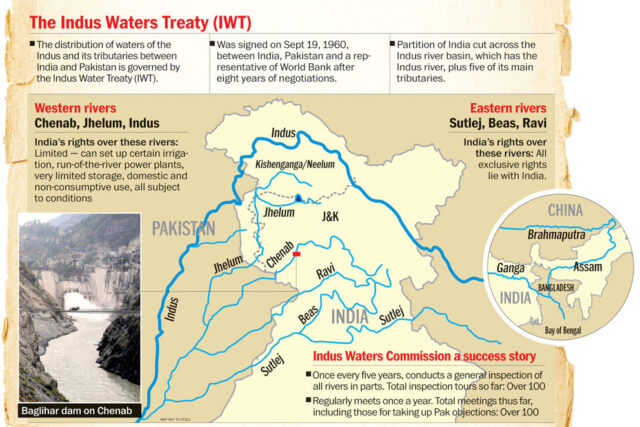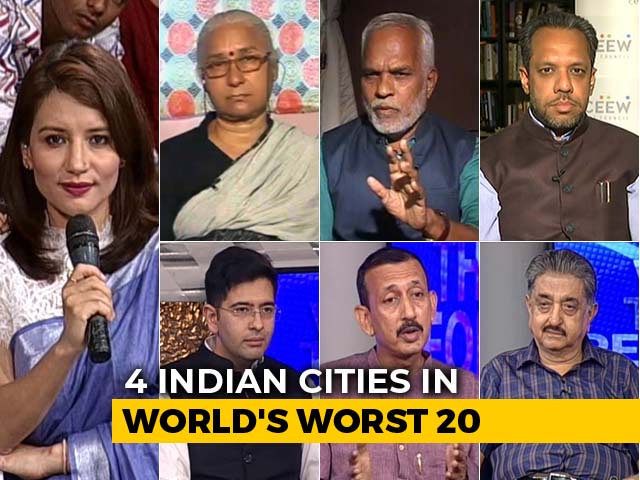Will the next decade be marked by confrontation over water and hydro energy, or will it be known for cooperation over sharing the natural resources? This is the second part of my series on India’s riparian relations with it’s neighbours
– Manohar Khushalani
Independent India’s first treaty with Communist China was marked by the 1954 Panchsheel Trade Agreement. This was the first official document signed with Mao’s China by a third party recognising Tibet as a region of the People’s Republic of China after the People’s Liberation Army’s invasion of Tibet in 1949. With this, India set its diplomatic relations with China on a weak footing, squandering the high ground of knowledge on the historic status of Tibet inherited from the British Empire.
China is the only neighbour, with whom India has geographically shared water resources, but there is no water sharing treaty so far. There seemed to be a great degree of timidity in this matter in the past, but it is changing now. The present government is now asserting itself as it holds national interest above everything else. The first written agreement pertaining to water is an MOU which the water resource ministries of the two countries have signed about provision of Hydrological Information of the Sutlej / Langqen Zangbo River in Flood Season by China to India. The MOU envisages provision of hydrological information in respect of the Sutlej / Langqen Zangbo River in flood season for flood control and disaster mitigation in downstream areas. The arrangement entailed building of a hydrological station by the Chinese side on the Sutlej / Langqen Zangbo River before the flood season of year 2006 and provision of hydrological information to the Indian side beginning the flood season of year 2006. The Chinese side was to bear the cost for setting up of the hydrological station and the Indian side would bear the cost for provision of the hydrological information and the operation of the hydrological station. The detailed implementation plan was to be finalised between the two sides.
According to the MOU, the Chinese side will provide information on any abnormal rise/fall in the water level/discharge and other information, which may lead to sudden floods on the basis of existing monitoring and data collection facilities on real time basis. Both sides will continue to discuss the possibility of providing hydrological information during flood season by China to India in respect of two more rivers – Parlung Zangbo1 and Lohit /Zayu Qu.
One recalls some time back, a program on BBC wherein Chinese army was shown trying to drain out a dam created by an earthquake by directly using artillery fire. On the flip side it is rumoured that China appears to be perfecting a procedure of creating instant dams by setting up a series of explosion and triggering a man made landslide. This will help it to divert large quantities of river water at short notice. Apparently some officials from Nathpa Jhakri project were allowed, after much reluctance, to visit China, where they have physically seen a lake on Parechu River that the Chinese claim was created by natural landslides.
There is not much reliable information on the present or proposed water-related developments and projects in the Tibet region. In the last few years, some arrangements were agreed upon on receiving information on glacial lake outbursts in the upper regions of the rivers that flow into India from the Tibet region of China, but information on the manner of its implementation, its comprehensiveness and the effectiveness thereof are not available.
In 2002, the Government of India had entered into an MOU with China for sharing of hydrological information on Yaluzangbo2/ Brahmaputra river in flood season by China to India. In accordance with the provisions contained in the MOU, the Chinese side was providing hydrological information (Water level, discharge and rainfall) in respect of three stations, namely Nugesha, Yangcun and Nuxia located on river Yarlungzangbo/ Brahmaputra from 1st June to 15th October every year. The requisite data up to the year 2004 was received and the same was utilised in formulation of flood forecasts by Central Water Commission.
India and China have now signed the implementation agreement for operationalising the MoU on sharing flood-related hydrological data for Brahmaputra which was renewed during Pranab Mukherjee’s, the then External Affairs Minister, visit to China in 2008. Under the agreement, China will continue providing flood-related data of its side of Brahmaputra during June 1-October 15 period each year till 2012. After 2012, both countries will have to renew their MoU and finalise a fresh implementation agreement. During this time window every year, the Chinese side will provide these hydrological data from three identified hydrological stations twice a day to India to help better manage floods.
For decades it is known that a great possibility of harnessing significant extent of hydropower exists at the giant U bend between Tibet and Arunachal Pradesh, in the upper reaches of the Brahmaputra. How this matter is being pursued is not known. It is reported3 that Chinese engineers had informed the Chinese Academy of Sciences that the waters of the upper Brahmaputra could be diverted into the arid northwestern region and Gobi desert using nuclear explosives. Publically this has been denied by the Chinese Government, as well as experts. At the Kathmandu Workshop of Strategic Foresight Group in August 2009 on ‘Water Security in the Himalayan Region’, which was attended by leading hydrologists from the Basin countries, the Chinese scientists argued that it was not feasible for China to undertake such a diversion4. In a subsequent meeting of the scientists at Dhaka, 25 leading experts from the Basin countries issued a ‘Dhaka Declaration’ on Water Security5 calling for exchange of information in low flow period, and other means of collaboration.
It has also been mentioned by some that the possibility of diverting from Yarlungzangpo to the upper Arun Kosi or Gandaki have also been mooted. No detailed or reliable information on these developments are available. However, the idea of diverting water from the South to the north is not new in China. The Grand Canal is, basically, more than a thousand years old. At the World Water Congress held in New Delhi in November 2005 China’s Vice-minister of Water resources Dr. Jiao Yong highlighted their problem of uneven distribution of water resources. He reiterated that the government was planning and constructing the South to North Water Diversion project, which can ultimately relieve water shortage in north China and northwest areas. No specific details or the final scope were made available.
The Indian government has been relaying its concern to Beijing since 2006 on Chinese reports that China intended to dam rivers like Yarlung Tsangpo / Brahmaputra and divert its waters to its arid north-east. Although China officially denied such an intention, the evidence against such a denial continues to mount. Indian officials have said the reports continued to abound inside China, including a proposed construction time table which was to have begun in 2009. Recent reports indicate that Chinese engineers are reportedly lobbying Beijing to ignore Indian concerns and dam the upper Brahmaputra in Tibet6 with what they envisage as the world’s biggest hydroelectric project and several smaller dams and tunnels. Tibetan researcher Tashi Tsering at the University of British Columbia, posted online a map of potential sites reportedly sourced from Chinese government website. China is likely to build a 38,000 MW power station near Motua wrote Tsering. He told Hindustan Times over email that: “China is likely to hold back water when it’s most needed in India, during spring, and release more during the monsoon.” Zhang Boting, an official of the China Society for Hydropower Engineering, backing a 38,000 MW Motuo dam proposal to generate renewable energy equivalent to the oil and gas in the South China Sea. Zhang said the dam research has been carried out but plans are not yet finalised7.
Any major storage or run-of-the-river projects for hydropower or navigation purposes planned in the Brahmaputra within China need not create difficulties for India, so long as the re-regulated flows from the power houses are returned to the river. On the other hand, consumptive uses or long distance transfer of waters outside the Basin to, say, the arid north China will hurt the interests of India and also Bangladesh.
What is making India think twice about Tibet now are geopolitical issues — how India and its South Asian neighbours might be adversely affected by what Beijing plans in Tibet. China’s development schemes for the Tibetan Plateau include large-scale mining, clear-fell deforestation, infrastructure- and road-building and firming up a burgeoning tourism industry8.
Meanwhile, Indians living on the banks of the mighty Brahmaputra have been devastated by death and destruction as the river changes its course every season and is affected by floods due to heavy siltation caused by the ruthless deforestation of Tibet. Environmentalists fear even more devastation and drought if China implements its plans to divert a part of the Brahmaputra.
Obviously there is a need for Indian leadership to engage the Chinese. A simple denial from Chinese polity or Water Resources experts would not guarantee a safe future. Perhaps an iron tight international riparian treaty similar to the Indus Water treaty would go a long way in diffusing possibility of future conflict. Since India has been unsuccessful so far would a third party intervention from the UN help? A word of caution however, China was among the only three countries that voted in the UN General Assembly in 1997 against the Convention on the Law of the Non-Navigational Uses of International Water Courses9.
1 Parlung Zangbo River is a major tributary of the Yarlung Zangbo
2 Due to lack of standardization, the Chinese equivalent of the Brahmaputra River is spelt in different texts in various phonetically similar sounding names such as; Yaluzangbo,Yarlungzangbo, Yarlung Zangpo, Yarlung Tsangpo, all the spellings have been used deliberately to be in consonance with the current usages.
3 Scientific American, June 1996
4 http://asiasecurity.macfound.org/images/uploads/news_attachments/Kathmandu_Workshop_Report.pdf [accessed March 18, 2010]
5 The New Nation, 17th January 2010 [ available at http://nation.ittefaq.com/issues/2010/01/17/news0350.htm [accessed on March 20, 2010]]
6 Reshma Patil report from Beijing in Hindustan Times, 26th May 2010
7 The Guardian, 25th May 2010
8 Hindustan Times, November 14, 2006
9 The other two were Burundi and Turkey

